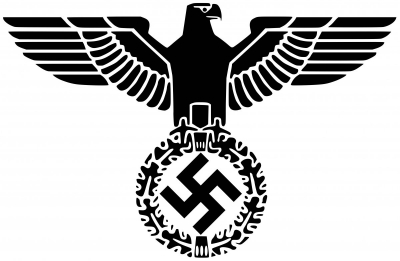Federal elections were held in Germany on 31 July 1932, following the premature dissolution of the Reichstag. The Nazi Party made significant gains and became the largest party in the Reichstag for the first time although they failed to win a majority. The Communist Party increased their vote share as well. The two parties jointly controlled a majority of the seats in the Reichstag, meaning no majority coalition government could be formed without including at least one of them.
The Nazi Party, officially the National Socialist German Workers' Party (German: Nationalsozialistische Deutsche Arbeiterpartei or NSDAP), was a far-right political party in Germany active between 1920 and 1945 that created and supported the ideology of Nazism. Its precursor, the German Workers' Party (Deutsche Arbeiterpartei; DAP), existed from 1919 to 1920. The Nazi Party emerged from the extremist German nationalist, racist and populist Freikorps paramilitary culture, which fought against the communist uprisings in post–World War I Germany. The party was created to draw workers away from communism and into völkisch nationalism. Initially, Nazi political strategy focused on anti–big business, anti‑bourgeois, and anti‑capitalist rhetoric. This was later downplayed to gain the support of business leaders, and in the 1930s the party's main focus shifted to antisemitic and anti‑Marxist themes.Pseudoscientific racist theories were central to Nazism, expressed in the idea of a "people's community" (Volksgemeinschaft). The party aimed to unite "racially desirable" Germans as national comrades, while excluding those deemed to be either political dissidents, physically or intellectually inferior, or of a foreign race (Fremdvölkische). The Nazis sought to strengthen the Germanic people, the "Aryan master race", through racial purity and eugenics, broad social welfare programs, and a collective subordination of individual rights, which could be sacrificed for the good of the state on behalf of the people. To protect the supposed purity and strength of the Aryan race, the Nazis sought to exterminate Jews, Romani, Poles and most other Slavs, along with the physically and mentally disabled. They disenfranchised and segregated homosexuals, black people, Jehovah's Witnesses, and political opponents. The persecution reached its climax when the party-controlled German state set in motion the Final Solution—an industrial system of genocide which achieved the murder of around 6 million Jews and millions of other targeted victims, in what has become known as the Holocaust.Adolf Hitler, the party's leader since 1921, was appointed Chancellor of Germany by President Paul von Hindenburg on 30 January 1933. Hitler rapidly established a totalitarian regime known as the Third Reich. Following the defeat of the Third Reich at the end of World War II in Europe, the party was "declared to be illegal" by the Allied powers, who carried out denazification in the years after the war both in Germany and in territories occupied by Nazi forces. The use of any symbols associated with the party is now outlawed in many European countries, including Germany and Austria.

1932Jul, 31
The NSDAP (Nazi Party) wins more than 38% of the vote in German elections.
Choose Another Date
Events on 1932
- 3Jan
United Fruit Company
Martial law is declared in Honduras to stop a revolt by banana workers fired by the United Fruit Company. - 18Feb
Manchuria
The Empire of Japan declares a puppet state of Manzhouguo (the obsolete Chinese name for Manchuria) independent from the Republic of China and installed former Chinese Emperor Aisin Gioro Puyi as Chief Executive of the State. - 1Mar
Lindbergh kidnapping
Charles Lindbergh's son is reportedly kidnapped. - 4May
Al Capone
In Atlanta, mobster Al Capone begins serving an eleven-year prison sentence for tax evasion. - 20Jul
Paul von Hindenburg
In the Preußenschlag ("Prussian coup"), German President Paul von Hindenburg dissolves the government of Prussia

 English
English  español
español  français
français  português
português  русский
русский  العربية
العربية  简体中文
简体中文 